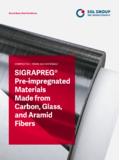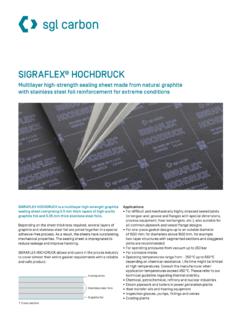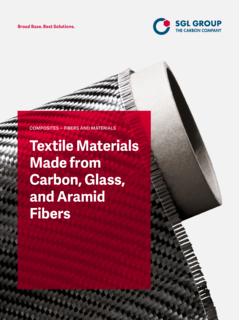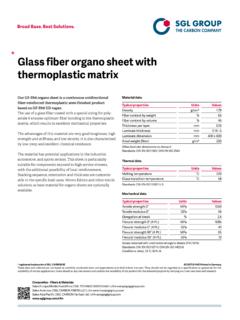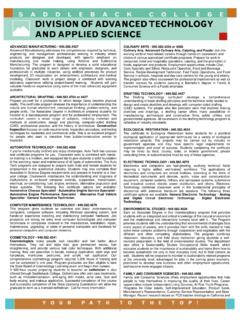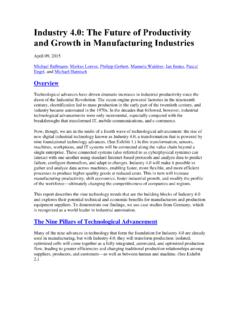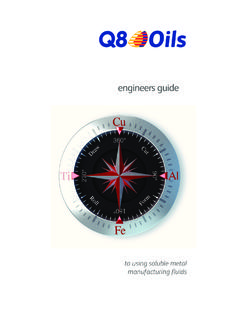Transcription of CARBOPRINT With Carbon into New Dimensions
1 with Carbon into New DimensionsAdditive Manufacturing with Carbon Materials and Post-Processing TechnologiesCARBOPRINT 2 with Carbon into new Dimensions made by SGL GroupSGL Group The Carbon Company is a leading global manufacturer of Carbon - based products. We have wide-ranging expertise in raw materials, advanced manu - facturing processes, and longstanding application and engineering know-how. Focusing on the technological challenges of megatrends, like digitalization and individualization, we develop innovative Carbon based solutions.
2 with additive manufacturing we open new Dimensions in respect to product design, performance and mANufACTuRed Carbon COmPONeNTsCARBOPRINT Additive manu - facturing with Carbon materials and post-processing technologies Classical Carbon based components are made by machining, which is a standard subtractive process. In contrast, additive manufacturing, such as 3D printing, is an innovative, material efficient, layer by layer process. It opens up new Dimensions of design P Polymer Carbon compositesCARBOPRINT SiCeramic carboncompositesCARBOPRINT CCarbon and graphiteCARBOPRINT M Metal Carbon compositesTogether with our partners and custo-mers we develop individual and new out of the box solutions for CARBOPRINT family combines our comprehensive Carbon material know-how with additive manufacturing technology.
3 In addition, our broad base of post-processing capabilities, such as metal, resin or silicon infiltration, delivers innovative material solutions for your set of competencies and capabili-ties is a unique starting point for rapid and economic production of prototypes and small series of Carbon based com-ponents for various industries such as glass, metal and chemicals, as well as high-temperature and mechanical material family aMetal infiltrationSiliconinfiltrationPolymer infiltration445 AddITIve mANufACTuRed Carbon COmPONeNTsBenefitting from unique Carbon proper ties and additive manufacturing technology Typical propertiesPost-processingTypesPotential componentsAdvantages of additive manufacturing with binder jetting technology Complex design at no additional cost (e.)
4 G. realization of undercuts and/or cavities) Acceleration of developments and production launch of small series Use of materials suitable for industrial applications Capabilty to produce large industrial componentsAdvantages of using Carbon in additive manufacturing Carbon and graphite specific properties (e. g. low weight, electrical and thermal conductivity, mechanical strength, chemical and high-temperature stability, low thermal expansion) Porous body structures deliver ideal basis for new material designs via metal, polymer or silicon infiltration Intelligent functions are possible (e.
5 G. heating and thermal management)None/ Carbon infiltrationPolymer infiltrationMetal infiltrationSilicon infiltrationCARBOPRINT CCARBOPRINT PCARBOPRINT MCARBOPRINT SiQ Low densityQ Open porosityQ Isotropic homogenous structureQ Complex designs with improved mechanical propertiesQ Accelerated developmentQ Good gliding propertiesQ High strength at elevated temperatureQ Good electrical and thermal conductivityQ High hardness low wearQ High temperature resistanceQ Good corrosion resistanceQ Casting coresQ Casting moldsQ PreformsQ Electrical contactsQ Gliding
6 ElementsQ Pump partsQ ElectrodesQ Heat exchanger componentsQ HeatersQ SealingsQ Casting moldsQ BearingsQ EDM electrodesQ Pump impellers and casingsQ Burner nozzlesQ Heat exchangersCARBOPRINT CFreedom of (material) designLightweight low density, open porosityProcessable like additive manufacturing sands6 Carbon and graphite powders are the basis for cost-efficient serial production of Carbon and graphite based components. Their porous bodies are binded with chemically and thermally stable duroplastic binder systems all with help of SGL Group s established processes and highly porous Carbon structure of CARBOPRINT C bodies is an ideal basis for post-processing, such as infiltration with silicon.
7 Or impregnation with polymers and C Carbon and graphite components d Porosity of printed Carbon delivers ideal basis for refinementb Carbon powder as the basis materialTypical material data for our CARBOPRINT CTypical propertiesUnitsC1 Densityg/cm porosity%40 50E-modulus GPa2 Flexural strengthMPa5 Electrical resistivity m125000 Thermal conductivityW/(mK)<1 CTE (at RT/150 C) m/(mK) PHeating functions Thermal properties of Carbon and resinsCTE CTE lower than pure polymersTemperature stabilityHeat resistant < 200 CNew material designs Infiltration of Carbon with polymers, i.
8 E. resinsLightweight Porous Carbon structure and low weight resinsElectrical and thermal conductivityAdjustable and high conductivities possible7 AddITIve mANufACTuRed Carbon COmPONeNTsApplications that require non-metallic materials will profit significantly from polymer Carbon material is temperature resistant up to 200 C without creeping effects common among other polymers. Depending on the choice of polymer, properties such as mechanical or chemical stability can be adjusted to customer P Polymer Carbon compositesa Choice of polymer increases material design variabilityTypical material data for our CARBOPRINT PTypical propertiesUnitsP1P2 Densityg/cm GPa66 Flexural strengthMPa1545 Electrical resistivity m35100000 Thermal conductivityW/(mK)40<1 CTE (at RT/150 C) m/(mK)1240d Sample part infiltrated with polymersCARBOPRINT SiEstablished manufacturing Key know-how in post-processing, i.
9 E. infiltrationLow CTE,high precisionTemperature resistanceUp to 1200 C and against thermo- shocksHigh hardness Strong resistance against abrasionLightweight Low density due to porous Carbon structure and siliconChemical stabilityGood oxidation and chemical resistance8 Ceramic Carbon composites provide ideal properties when it comes to reliable function and longevity in harsh environments and at high temperatures. We bring decades of experience with ceramic composites to additive manufacturing, in order to provide our customers the opportunity to realize almost any design with ceramic Carbon composites.
10 CARBOPRINT SI components are made by siliconi-zing CARBOPRINT C Si Ceramic Carbon compositesc Silicon used in our infiltration processTypical material data for our CARBOPRINT SiTypical propertiesUnitsSi1 Densityg/cm Open < E-modulus GPa35 Flexural strengthMPa60 Elongation at break% Bending energy absorptionNmm340 Electrical resistivity m20 Thermal conductivityW/(mK)50 CTE (at RT/200 C) m/(mK)3 Silicon carbide Silicon free d Pump impeller in CARBOPRINT SiCARBOPRINT MSimplicity No specialized metal powder necessary CTEL ower CTE than pure metalsThermal & electrical properties adjustablecombining Carbon and metal advantagesFlexibility Available choice of metals depending on component functionLightweight Lower density than that of pure metalsLower wearGood gliding properties9 AddITIve mANufACTuRed Carbon COmPONeNTsMetal Carbon composites are designed for purposes where the combination of metal and Carbon properties are
